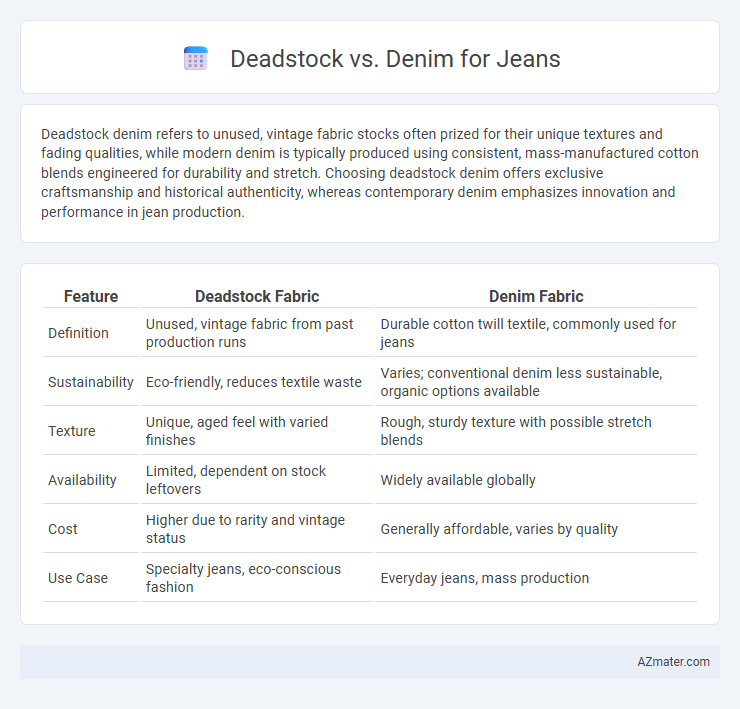Deadstock denim refers to unused, vintage fabric stocks often prized for their unique textures and fading qualities, while modern denim is typically produced using consistent, mass-manufactured cotton blends engineered for durability and stretch. Choosing deadstock denim offers exclusive craftsmanship and historical authenticity, whereas contemporary denim emphasizes innovation and performance in jean production.
Table of Comparison
| Feature | Deadstock Fabric | Denim Fabric |
|---|---|---|
| Definition | Unused, vintage fabric from past production runs | Durable cotton twill textile, commonly used for jeans |
| Sustainability | Eco-friendly, reduces textile waste | Varies; conventional denim less sustainable, organic options available |
| Texture | Unique, aged feel with varied finishes | Rough, sturdy texture with possible stretch blends |
| Availability | Limited, dependent on stock leftovers | Widely available globally |
| Cost | Higher due to rarity and vintage status | Generally affordable, varies by quality |
| Use Case | Specialty jeans, eco-conscious fashion | Everyday jeans, mass production |
Understanding Deadstock Fabric: Definition and Origins
Deadstock fabric refers to surplus or unused textile material originally produced for a specific purpose but never sold or used, often found in vintage or archival collections. In denim, deadstock fabrics typically originate from mid-20th century mills known for their robust weaving techniques and unique indigo dyeing processes, resulting in high-quality, authentic material sought after by collectors and designers. Understanding deadstock denim involves recognizing its historic production context, rare availability, and its potential for creating exclusive, durable, and character-rich jeans.
What is Denim? History and Composition
Denim is a durable cotton twill fabric characterized by its diagonal ribbing and indigo-dyed warp threads, making it ideal for jeans due to its strength and comfort. Originating in the late 18th century in Nimes, France, the fabric's name is derived from "serge de Nimes," reflecting its French roots. Composed primarily of 100% cotton or a cotton blend with elastane for stretch, denim has evolved to become a staple textile in fashion and workwear.
Deadstock vs Denim: Key Differences
Deadstock refers to brand-new, unworn denim fabric or jeans that have never been sold or used, often older stock from past collections preserving vintage quality and unique materials. Denim, by contrast, is the widely used cotton twill fabric that constitutes most jeans, available in various weights, finishes, and washes, representing both new and used goods. The key difference lies in deadstock's exclusivity and rarity, offering untouched fabric with historical value, while denim broadly encompasses all jean materials regardless of age or condition.
Sustainability: Deadstock Fabric vs Traditional Denim
Deadstock fabric significantly reduces environmental impact by repurposing surplus materials that would otherwise contribute to textile waste, contrasting with traditional denim production which often involves high water usage and chemical treatments. Utilizing deadstock promotes circular fashion by extending the lifecycle of existing fabrics, thereby minimizing the demand for virgin cotton cultivation and dyeing processes. Sustainable jean manufacturing increasingly favors deadstock denim to lower carbon footprints and support eco-friendly consumption practices.
Cost Comparison: Deadstock vs Regular Denim Jeans
Deadstock jeans typically come at a higher cost due to their limited availability and vintage appeal, often priced 20-40% above regular denim jeans. Regular denim is mass-produced with standardized materials, resulting in lower prices and consistent quality. Consumers seeking unique, rare fabric often pay a premium for deadstock, while budget-conscious buyers find regular denim more affordable.
Quality and Durability: Which Lasts Longer?
Deadstock denim, crafted from unused, vintage fabric, often boasts superior quality due to its aged fibers and traditional weaving techniques, resulting in enhanced durability compared to modern denim. Contemporary denim tends to prioritize fashion trends with varied blends and finishes that may compromise long-term wear resistance. When evaluating longevity, deadstock denim typically outlasts regular denim jeans, maintaining structure and color retention through extended use.
Unique Style Potential: Design Advantages
Deadstock denim offers a unique style potential through its rare vintage fabrics and distinctive textures, allowing designers to create one-of-a-kind jeans that stand out in the market. Unlike standard mass-produced denim, deadstock materials often feature limited patterns and finishes that add character and authenticity to each garment. This exclusivity provides creative freedom in design, enhancing the uniqueness and appeal of denim products.
Environmental Impact of Deadstock and Denim
Deadstock denim reduces environmental impact by repurposing unused fabric, minimizing textile waste and lowering resource consumption associated with new denim production. Conventional denim manufacturing requires extensive water usage, chemical dyes, and energy, contributing significantly to pollution and carbon emissions. Choosing deadstock promotes sustainable fashion by extending fabric lifecycle and decreasing landfill waste compared to traditional denim processes.
Ethical Considerations in Fabric Choice
Deadstock denim significantly reduces environmental impact by repurposing unused, vintage fabric, preventing textile waste from landfills and limiting the need for new cotton cultivation. Ethical considerations highlight that using deadstock supports sustainable fashion by minimizing water consumption, pesticide use, and carbon emissions compared to producing conventional denim. Choosing deadstock denim aligns with eco-conscious consumer values and promotes responsible resource management across the apparel industry.
Choosing the Best Fabric for Your Next Pair of Jeans
Deadstock denim offers unique, vintage fabrics sourced from unused rolls, providing rare textures and sustainability benefits, while modern denim ensures consistent quality and a wide variety of finishes. Choosing between deadstock and contemporary denim depends on preferences for exclusivity, environmental impact, and fabric consistency. Evaluate the weight, weave, and origin of the denim to select the best fabric for durability, comfort, and style in your next pair of jeans.

Infographic: Deadstock vs Denim for Jean
 azmater.com
azmater.com